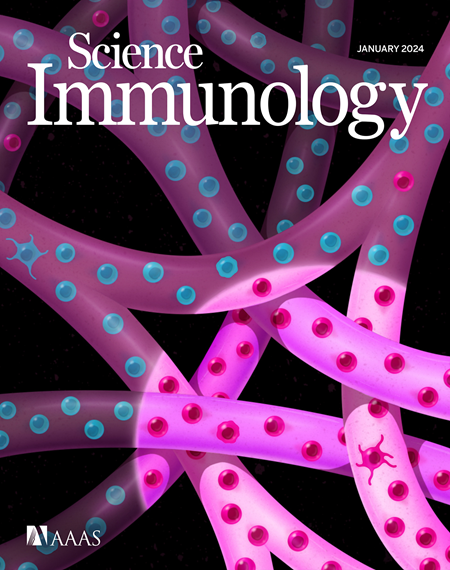成纤维网状细胞在人淋巴结中形成反应性骨髓细胞壁龛
IF 17.6
1区 医学
Q1 IMMUNOLOGY
引用次数: 0
摘要
淋巴结在维持体内平衡和炎症组织中的液体平衡中发挥关键作用,并为最佳的免疫细胞定位和相互作用提供成纤维细胞生态位环境。在这里,我们使用单细胞和空间转录组学分析结合高分辨率成像来分子定义和功能表征控制人类淋巴结炎症驱动重塑的利基形成细胞。纤维母细胞网状细胞通过激活和扩展平衡的生态位环境来响应炎症扰动。炎症诱导的淋巴结基础设施和地形的适应包括肽酶抑制剂16 (PI16)表达的网状细胞(PI16 + RC)网络的扩张,这些网络包裹着静脉周围导管系统。Interactome分析表明,巨噬细胞来源的抑癌素M指导炎症淋巴结的PI16 + RC激活,从而促进静脉周围空间的免疫细胞聚集。总之,这些数据表明,人类淋巴结的炎症重塑导致PI16 + RCs形成反应性骨髓细胞龛。本文章由计算机程序翻译,如有差异,请以英文原文为准。

Fibroblastic reticular cells form reactive myeloid cell niches in human lymph nodes
Lymph nodes play a key role in maintaining fluid balance in homeostatic and inflamed tissues and provide fibroblastic niche environments for optimal immune cell positioning and interaction. Here, we used single-cell and spatial transcriptomic analyses in combination with high-resolution imaging to molecularly define and functionally characterize niche-forming cells that control inflammation-driven remodeling in human lymph nodes. Fibroblastic reticular cells responded to inflammatory perturbation with activation and expansion of poised niche environments. Inflammation-induced adaptation of lymph node infrastructure and topography included the expansion of peptidase inhibitor 16 (PI16)–expressing reticular cell (PI16+ RC) networks that enwrap the perivenular conduit system. Interactome analyses indicated that macrophage-derived oncostatin M directs PI16+ RC activation in inflamed lymph nodes and thereby promotes immune cell aggregation in the perivenular space. In conclusion, these data demonstrate that the inflammatory remodeling of human lymph nodes results in the formation of reactive myeloid cell niches by PI16+ RCs.
求助全文
通过发布文献求助,成功后即可免费获取论文全文。
去求助
来源期刊

Science Immunology
Immunology and Microbiology-Immunology
CiteScore
32.90
自引率
2.00%
发文量
183
期刊介绍:
Science Immunology is a peer-reviewed journal that publishes original research articles in the field of immunology. The journal encourages the submission of research findings from all areas of immunology, including studies on innate and adaptive immunity, immune cell development and differentiation, immunogenomics, systems immunology, structural immunology, antigen presentation, immunometabolism, and mucosal immunology. Additionally, the journal covers research on immune contributions to health and disease, such as host defense, inflammation, cancer immunology, autoimmunity, allergy, transplantation, and immunodeficiency. Science Immunology maintains the same high-quality standard as other journals in the Science family and aims to facilitate understanding of the immune system by showcasing innovative advances in immunology research from all organisms and model systems, including humans.
 求助内容:
求助内容: 应助结果提醒方式:
应助结果提醒方式:


